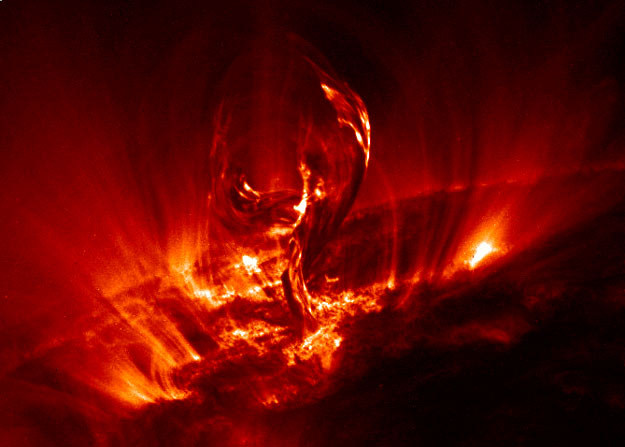
Posted on 08/05/2004 11:24:55 AM PDT by Pyro7480
2004 July 25

Explanation: Hot gas frequently erupts from the Sun. One such eruption produced the glowing filament pictured above, which was captured in 2000 July by the Earth-orbiting TRACE satellite. The filament, although small compared to the overall size of the Sun, measures over 100,000 kilometers in height, so that the entire Earth could easily fit into its outstretched arms. Gas in the filament is funneled by the complex and changing magnetic field of the Sun. After lifting off from the Sun's surface, most of the filamentary gas will eventually fall back. More powerful solar eruptions emit particles that reach the Earth and can disrupt manmade satellites. The cause and nature of solar eruptions are the topic of much research.
2004 July 26
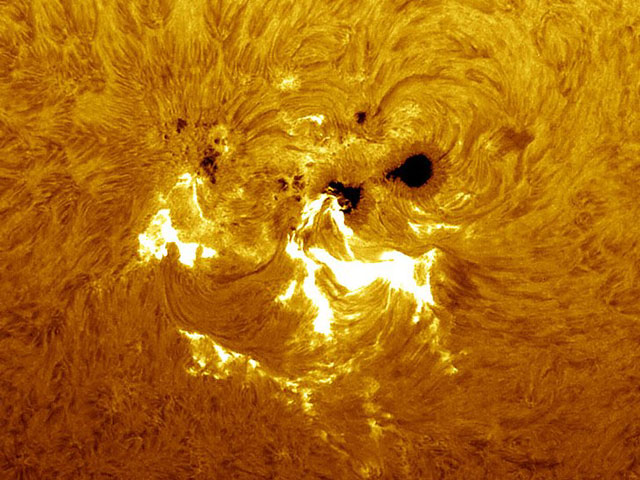
Explanation: An unexpectedly large sunspot region is now crossing the Sun. The active region is home to rivers of hot plasma, explosive flares, strong magnetic fields, a powerful Coronal Mass Ejection (CME), and a sunspot group so large it can be seen by the protected eye without magnification. In fact, this region appears larger than Venus did when it crossed the Sun last month. Pictured above is a close-up of this sunspot group, officially tagged AR 10652, taken just four days ago. The region is now nearing the Sun's eastern limb and will disappear from view in a few days. Energetic ions from sunspot group 652 continue to impact the Earth and create rare purple auroras.
2004 July 27
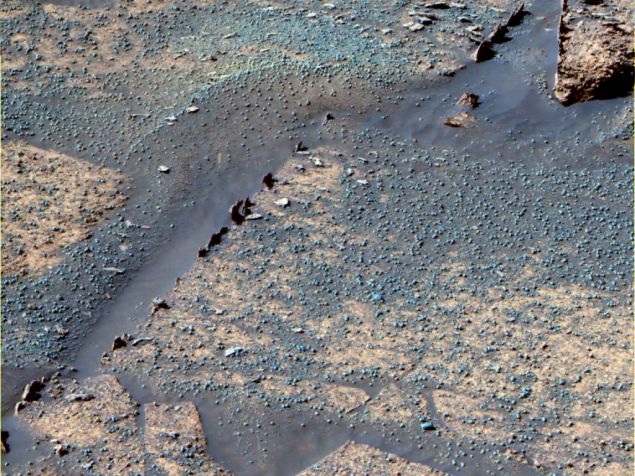
Explanation: Over one year after its launch, robot geologist Opportunity has been spending recent sols on Mars inching its way down the slopes of Endurance crater. Littered with martian blueberries, some flat rocks within the crater also seem to have surprising razorbacks -- narrow slabs sticking up along their edges. Like the blueberries, it's possible that the sharp, narrow features are related to water. They could be formed by minerals deposited by water in cracks, with the surrounding softer material subsequently eroded away. How narrow are they? The ones pictured here in an enhanced color image from Opportunity's panoramic camera are actually only a few centimeters high and about half a centimeter wide. Impressive 3D views have been constructed by stereo experimenter P. Vantuyne based on the camera's left and right eye images of the region.
2004 July 28
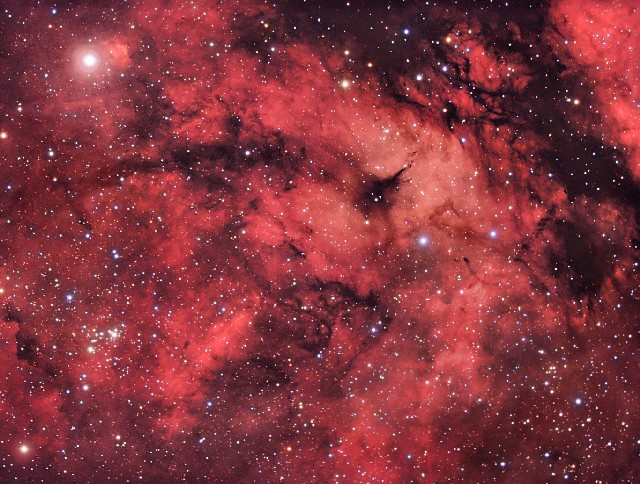
Explanation: In the constellation of the swan near the nebula of the pelican lies the gas cloud of the butterfly surrounding a star known as the hen. That star, given the proper name Sadr, is visible to the unaided eye but found here as the brightest object on the upper left. Sadr, at 1500 light years distant, is near the center of the Butterfly Nebula (IC 1318) in a bright region given the comparatively staid label of IC 1318B. The fantastic starfield that surrounds Sadr contains stars old and young, an open cluster of stars (NGC 6910 visible on the image left), vast clouds of hydrogen gas that glow red, and picturesque pockets and filaments of dark dust. The above image is a digital fusion of several different color images of the gamma Cygni (Sadr) region.
2004 July 29

Explanation: Steep cliffs drop into the rugged terrain of Melas Chasma in this stunning view from the Mars Express spacecraft orbiting the Red Planet. At a scale of 16 meters per pixel, the image data from the orbiter's High Resolution Stereo Camera offers evidence that volcanic activity, water, wind erosion and marsquakes may all have shaped the region. Melas Chasma lies along the central southern edge of the large Valles Marineris, the grand canyon of Mars. While the Valles Marineris is itself over 4,000 kilometers long and up to 10 kilometers deep, the region pictured spans about 70 kilometers. The floor of Melas Chasma seen here is several kilometers below the surrounding plateau.
2004 July 30
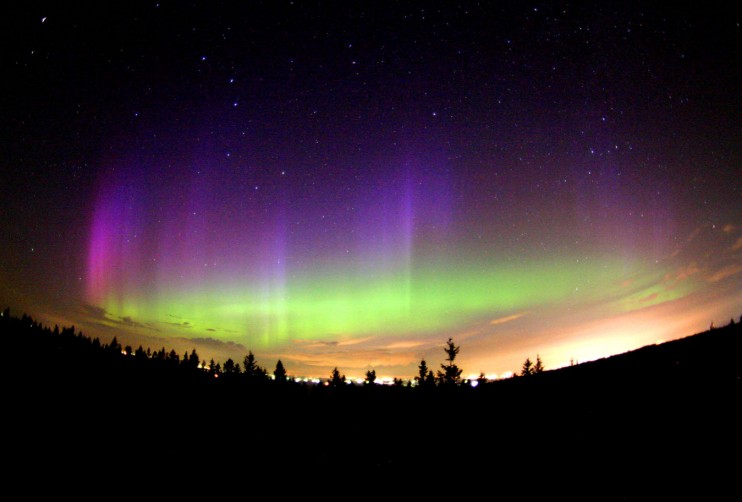
Explanation: While enjoying the spaceweather on a gorgeous summer evening in mid-July, astronomer Philippe Moussette captured this colorful fish-eye lens view looking north from the Observatoire Mont Cosmos, Quebec, Canada, planet Earth. In the foreground, lights along the northern horizon give an orange cast to the low clouds. But far above the clouds, at altitudes of 100 kilometers or more, are alluring green and purple hues of the aurora borealis or northern lights, a glow powered by energetic particles at the edge of space. In the background are familiar stars of the northern sky. In particular, that famous celestial kitchen utensil, the Big Dipper (left), and the W-shaped constellation Cassiopeia (right) are easy to spot. Then, just follow the pointer stars of the Big Dipper to Polaris, perhaps the most famous northern light of all.
2004 July 31
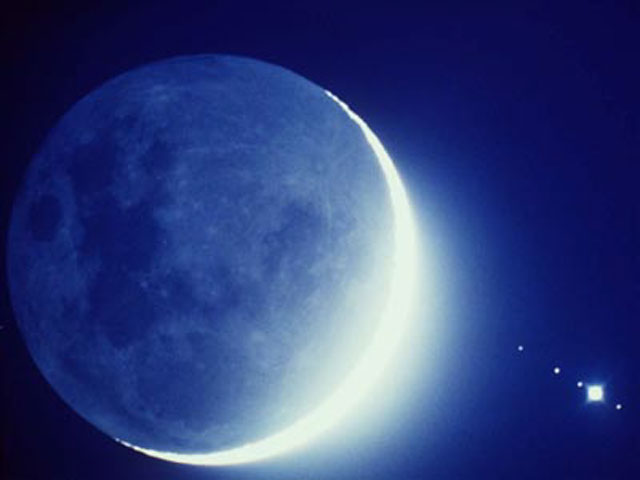
Explanation: How often does a full moon occur twice in a single month? Exactly once in a Blue Moon. In fact, the modern usage of the term "Blue Moon" refers to the second Full Moon in a single month. Tonight's Blue Moon will be the first since November 2001. A Blue Moon typically occurs every few years. The reason for the rarity of the Blue Moon is that the 29.53 days between full moons is just slightly shorter than the number of days in the average month. Don't, however, expect the moon to look blue tonight! The term "Blue Moon" has recently been traced to an error in a magazine article in 1946. It is possible for the Moon to appear tinged by a blue hue, sometimes caused by fine dirt circulating in the Earth's atmosphere, possibly from a volcanic explosion. The above picture was taken not during a full moon but through a morning sky that appeared dark blue. The bright crescent is the only part directly exposed to sunlight - the rest of the Moon glows from sunlight reflected from the Earth. In this dramatic photo, however, the planet Jupiter is also visible along with its four largest moons.
APOD ping!
Howard Dean's brain...
Thank You.
I feel much better now.
Thank you Pyro
Wow -- if that pic of the solar filament (7/25) doesn't look demonic!
Thanks for the recap of the "fiery" APOD images, Pyro...
Disclaimer: Opinions posted on Free Republic are those of the individual posters and do not necessarily represent the opinion of Free Republic or its management. All materials posted herein are protected by copyright law and the exemption for fair use of copyrighted works.